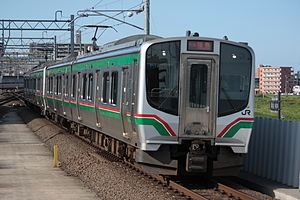Native name 東北本線 Track gauge 1,067 mm (3 ft 6 in) | Line length 575.7 km (357.7 mi) Operating speed | |
 | ||
Electrification 1,500 V DC from Tokyo to Kuroiso
20 kV AC, 50Hz from Kuroiso to Morioka Owner East Japan Railway Company Terminis Tokyo Station, Morioka Station Locale Kantō region, Tōhoku region | ||
The Tōhoku Main Line (東北本線, Tōhoku-honsen) is a 575.7 km long railway line in Japan operated by the East Japan Railway Company (JR East). Although officially the line starts from Tokyo Station in Chiyoda, Tokyo, most of the long-distance trains actually begin at Ueno Station in Taitō, Tokyo, and pass through such cities as Saitama, Utsunomiya, Fukushima, and Sendai, before reaching the end of the line in Morioka. The line originally extended to Aomori, but was truncated upon the extension of the Tōhoku Shinkansen beyond Morioka, which mostly parallels the Tōhoku Main Line.
Contents
- Ueno Kuroiso
- Kuroiso Sendai
- Sendai Morioka
- Kuroiso Ichinoseki
- Ichinoseki Morioka
- History
- Double tracking
- Electrification
- Saitama Prefecture
- Tochigi Prefecture
- Fukushima Prefecture
- Miyagi Prefecture
- Iwate Prefecture
- Aomori Prefecture
- References
The 159.9 km long portion of the line between Ueno Station and Kuroiso Station in Nasushiobara, Tochigi is often referred to as the (JR) Utsunomiya Line. A portion of the Tōhoku Main Line is also shared with the Keihin-Tōhoku Line (29.6 km between Tokyo Station and Ōmiya Station in Ōmiya-ku, Saitama) and the Saikyō Line (18.0 km between Akabane Station in the Kita ward of Tokyo and Ōmiya Station).
Ueno – Kuroiso
The section between Ueno and Kuroiso is known as the Utsunomiya Line.
Kuroiso – Sendai
Sendai – Morioka
Kuroiso – Ichinoseki
Ichinoseki – Morioka
History
The construction of the Tōhoku Main Line began in the Kantō region and extended to the north end of Honshu, and the city of Aomori. It is one of oldest railway lines in Japan, with construction beginning in the late 19th century. Until November 1, 1906, the current Tōhoku Main Line was run by a private company Nippon Railway.
In 1883, the first segment between Ueno and Kumagaya opened. In 1885, it was extended to Utsunomiya, but the Tone River had to be crossed by boat. Following construction of the Tone River Bridge in 1886, Utsunomiya and Ueno were directly connected. The line gradually extended further to the north; to Kōriyama, Sendai, Ichinoseki and Morioka. In 1891, the segment between Morioka and Aomori opened, creating the longest continuous railway line in Japan.
After 1906, the line was nationalized and became the Tohoku Main Line operated by the Ministry of Railways. When Tokyo Station opened in 1925, the Tōhoku Main Line was extended from Ueno to the new station. Until the 1950s, this segment was used and many trains ran through both the Tōkaidō Main Line and Tohoku Main Line. However, when the Tohoku Shinkansen opened, it occupied land previously used for the tracks of mid and long-distance Tohoku Main Line trains. As a result, only a small number of commuter lines such as the Keihin-Tohoku Line now operate to Tokyo from the north, making Tokyo Station's status as part of the Tōhoku Main Line somewhat circumspect. This is set to change in March 2015 when the under-construction Ueno-Tokyo Line is completed, facilitating through service between the Tōkaidō Line and the Utsunomiya and Joban Lines.
In 2002, the Tohoku Shinkansen was extended from Morioka to Hachinohe and the operations of the local track segment between those two cities was turned over to Iwate Ginga Railway (IGR) and Aoimori Railway. With the extension of the Tōhoku Shinkansen to Shin-Aomori station in 2010, the segment between Hachinohe and Aomori was delegated to the Aoimori Railway Company. The shortened Tōhoku Main Line is now the second-longest line in Japan, after the Sanin Main Line.
Double-tracking
The Tokyo to Omiya section was double-tracked between 1892 and 1896, extended to Furukawa in 1908, Koyama the following year, and to Utsunomiya in 1913.
The Iwanuma - Sendai - Iwakiri section was double-tracked between 1920 & 1923 and the Utsunomiya - Iwanuma section between 1959 and 1964. The Iwakiri - Morioka - Aomori section was double-tracked between 1951 and 1968, including the 17 km realigned section between Iwakiri and Atago in 1962.
Electrification
The 7 km Tokyo to Tabata section was electrified at 1,500 V DC in 1909, extended to Akabane in 1928, Omiya in 1932 and Kuroiso in 1959. Electrification was then continued north at 20 kV AC, reaching Fukushima in 1960, Sendai in 1961, Morioka in 1965, and Aomori in 1968.
